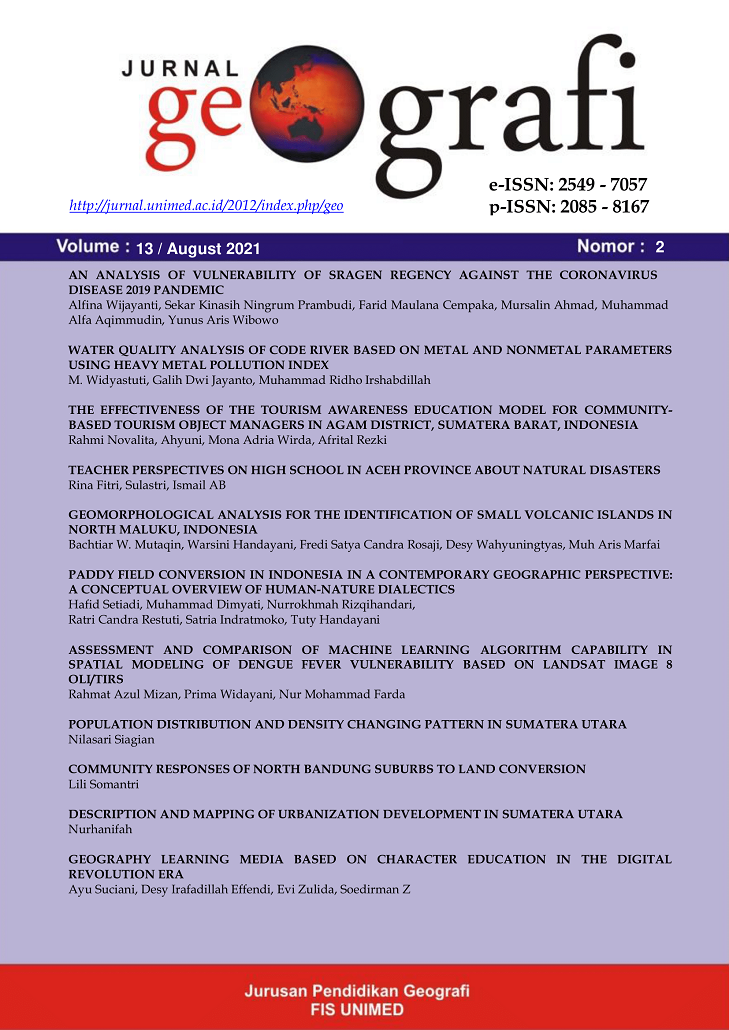WATER QUALITY ANALYSIS OF CODE RIVER BASED ON METAL AND NONMETAL PARAMETERS USING HEAVY METAL POLLUTION INDEX
DOI:
https://doi.org/10.24114/jg.v13i2.20000Abstract
Code is one of the rivers influenced by a large number of waste-generating human activities in Yogyakarta, Indonesia. Despite continued discharges of pollution loads from anthropogenic waste, the heavy metal pollution index (HPI)”a water quality index assessing heavy metal ions present in a body of water”remains nationally underutilized. The research was intended to 1) analyze the river water quality based on metal and nonmetal parameters typical of domestic waste, 2) calculate HPI using either and both parameters, and 3) evaluate the resultant water quality status. The water quality data were the products of temporal river monitoring conducted by the Forestry and Environmental Office for Yogyakarta. The heavy metal parameters included Fe, Cu, Cd, Cr, and Pb, while the nonmetal parameters were BOD, COD, TSS, ammonia, oil and grease, and total coliforms. Each parameter value was compared with the water quality standard issued in Governor Regulation No. 20/2008. The results showed that the HPI composite of heavy metal parameters classified the river water quality as excellent (2.52), whereas the one representing nonmetal parameters indicated bad quality (55.04). Nevertheless, based on the HPI composed of all parameters, the quality fell into the category excellent (3.94). Consequently, when all metal and nonmetal parameters are combined into the HPI calculation, the river shows a better water quality status.Keywords: HPI (Heavy Metal Pollution Index) water quality, domestic waste, heavy metal, YogyakartaReferences
Abdel-Satar, A. M., Ali, M. H., & Goher, M. E. (2017). Indices of water quality and metal pollution of Nile River, Egypt. Egyptian Journal of Aquatic Research, 43(1), 21“29.
Adeola Fashae, O., Abiola Ayorinde, H., Oludapo Olusola, A., & Oluseyi Obateru, R. (2019). Landuse and surface water quality in an emerging urban city. Applied Water Science, 9(2), 1“12.
Adhitya, Y., Prasetya, D., & Rengganis, H. (2017). Pemanfaatan Sumber-sumber Air Untuk Mendukung Irigasi Pertanian Tebu di Kaki Gunung Tambora. Jurnal Teknik Hidraulik, 8(1), 1“15.
Bora, M., & Goswami, D. C. (2017). Water quality assessment in terms of water quality index (WQI): case study of the Kolong River, Assam, India. Applied Water Science, 7(6), 3125“3135.
Ding, J., Jiang, Y., Fu, L., Liu, Q., Peng, Q., & Kang, M. (2015). Impacts of land use on surface water quality in a subtropical river basin: A case study of the dongjiang river basin, Southeastern China. Water (Switzerland), 7(8), 4427“4445.
Eljaiek-Urzola, M., Romero-Sierra, N., Segrera-Cabarcas, L., Valdelamar-MartÃnez, D., & Quiñones-Bolaños, É. (2019). Oil and grease as a water quality index parameter for the conservation of marine biota. Water (Switzerland), 11(4).
Ester Suoth, A., & Nazir, E. (2016). Karakteristik Air Limbah Rumah Tangga Pada Salah Satu Perumahan Menengah Keatas Di Tangerang Selatan. Jurnal Ecolab, 10(2), 80“88.
Giri, S., & Singh, A. K. (2014). Assessment of Surface Water Quality Using Heavy Metal Pollution Index in Subarnarekha River, India. Water Quality, Exposure and Health, 5(4), 173“182.
Gusril, H. (2016). Studi Kualitas Air Minum PDAM di Kota Duri Riau. Jurnal Geografi, 8(2), 1“7.
Imroatushshoolikhah, Purnama, I. S., & Suprayogi, S. (2014). Kajian Kualitas Air Sungai Code Propinsi Daerah Istimewa Yogyakarta. Majalah Geografi Indonesia, 28(1), 23“24.
Jenkins, D., & Russell, L. L. (1994). Heavy metals contribution of household washing products to municipal wastewater. Water Environment Research, 66(6), 805“813.
Kritzberg, E. S., & Ekström, S. M. (2012). Increasing iron concentrations in surface waters - A factor behind brownification? Biogeosciences, 9(4), 1465“1478.
Kumar, A. Y., & Reddy, M. V. (2009). Assessment of seasonal effects of municipal sewage pollution on the water quality of an urban canal - A case study of the Buckingham canal at Kalpakkam (India): NO3, PO4, SO4, BOD, COD and DO. Environmental Monitoring and Assessment, 157(1“4), 223“234.
Li, S., Gu, S., Liu, W., Han, H., & Zhang, Q. (2008). Water quality in relation to land use and land cover in the upper Han River Basin, China. Catena, 75(2), 216“222.
Mokarram, M., Saber, A., & Sheykhi, V. (2020). Effects of heavy metal contamination on river water quality due to release of industrial effluents. Journal of Cleaner Production, 277, 123380.
Öztürk, M., Ashraf, M., Aksoy, A., Ahmad, M. S. A., & Hakeem, K. R. (2016). Plants, pollutants and remediation. Plants, Pollutants and Remediation, 1“404.
Pohan, D. A. S., Budiyono, B., & Syafrudin, S. (2017). Analisis Kualitas Air Sungai Guna Menentukan Peruntukan Ditinjau Dari Aspek Lingkungan. Jurnal Ilmu Lingkungan, 14(2), 63.
Saraswati, S. P., Sunyoto, Kironoto, B. A., & Hadisusanto, S. (2014). Penentuan Status Mutu Perairan Sungai Tropis di Indonesia (Assessment of the Forms and Sensitivity of the Index Formula PI , Storet , CCME for The Determination of Water Quality Status of A Tropical Stream in Indonesia). Jurnal Manusia Dan Lingkungan, 21(2), 129“142.
Shanbehzadeh, S., Vahid Dastjerdi, M., Hassanzadeh, A., & Kiyanizadeh, T. (2014). Heavy metals in water and sediment: A case study of Tembi River. Journal of Environmental and Public Health, 2014.
Soylak, M., Unsal, Y. E., & Tuzen, M. (2013). Evaluation of metal contents of household detergent samples from Turkey by flame atomic absorption spectrometry. Environmental Monitoring and Assessment, 185(11), 9663“9668.
























